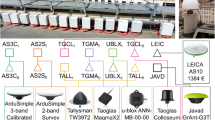Abstract
Global Navigation Satellite System interferometric reflectometry (GNSS-IR) can be used to monitor a series of geophysical parameters in a cost-effective manner with high temporal resolution. The technique makes use of the simultaneous reception of direct and reflected GNSS signals with a single antenna. Based on the low-cost u-blox M8N chips, a GNSS-IR instrument is developed, which could be used to collect and process GNSS signals automatically and save and transmit generated GNSS data. Details about the instrument are described here for the first time. Then, the recorded SNR observation characteristics are analyzed by comparing three in-situ SNR sequences, which are simultaneously collected by the instrument with a low-cost patch antenna and a geodetic antenna and by a geodetic GNSS receiver with a geodetic antenna. Based on the developed function relating the peak power spectral density to peak frequency estimation error of the low-cost instrument, a weighting method is proposed to fuse multiple estimations of the reflector height to improve the estimation accuracy of the GNSS-IR-based reflector height. The performances of the developed low-cost instrument and the proposed reflector height estimation method are evaluated using a data set collected in Xinxiang City, Henan, China, over 6 days. The results show that there exists good agreement between the instrument-based reflector height estimates and the ground-truth estimates, with root-mean-square errors of 1.1 cm and 0.4 cm for the normal average and the proposed weighted average results, respectively, when the antenna height is in the range of 0.65 m to 2.15 m and the reflecting surface is flat, silty loam soil ground.












Similar content being viewed by others
Data availability
The GNSS-IR simulator and Trimble GNSS antenna gain data are available at http://www.ngs.noaa.gov/gpstoolbox. The u-blox GNSS antenna gain data are available at https://www.u-blox.com/en/product/ann-mb-series. The GNSS data are available upon request to Prof. Taoyong Jin (tyjin@sgg.whu.edu.cn).
Change history
18 August 2021
A Correction to this paper has been published: https://doi.org/10.1007/s10291-021-01172-5
References
Chang X, Jin TY, Yu KG, Li YW, Li JC, Zhang Q (2019) Soil moisture estimation by GNSS multipath signal. Remote Sens 11(21):2559–2575
Crespo JA, Posselt DJ, Asharaf S (2019) CYGNSS surface heat flux product development. Remote Sens 11(19):2294–2314
Fagundes MAR, Tinti IM, Lescheck AL, Akos DM, Nievinski FG (2021) An open-source low-cost sensor for SNR-based GNSS reflectometry: design and long-term validation towards sea level altimetry. GPS Solut 25(73):1–11
Hyunglok K, Venkat L (2018) Use of cyclone global navigation satellite system (CYGNSS) observations for estimation of soil moisture. Geophys Res Lett 45(3):1–16
Larson KM, Gutmann ED, Zavorotny VU, Braun JJ, Williams MW, Nievinski FG (2009) Can we measure snow depth with GPS receivers? Geophys Res Lett 36(17):1–5
Larson KM, Ray RD, Williams SP (2017) A ten year comparison of water levels measured with a geodetic GPS receiver versus a conventional tide gauge. J Atmos Ocean Tech 34(2):295–307
Li YW, Chang X, Yu KG, Wang SY, Li JC (2019) Estimation of snow depth using pseudorange and carrier phase observations of GNSS single-frequency signal. GPS Solut 23(4):118–131
Morris M, Ruf CS (2017) Determining tropical cyclone surface wind speed structure and intensity with the CYGNSS satellite constellation. J Appl Meteorol Climatol 56(7):1847–1865
Nievinski FG, Larson KM (2014) An open source GPS multipath simulator in matlab/octave. GPS Solut 18(3):473–481
Rover S, Vitti A (2019) GNSS-R with low-cost receivers for retrieval of antenna height from snow surfaces using single-frequency observations. Sensors 19(24):5536–5550
Ruf CS, Gleason S, Mckague DS (2019) Assessment of CYGNSS wind speed retrieval uncertainty. IEEE J Sel Top Appl Earth Obs Remote Sens 12(1):87–97
Strandberg J, Haas R (2020) Can we measure sea level with a tablet computer? IEEE Geosci Remote Sens Lett 17(11):1876–1878
Tabibi S, Nievinski FG, Dam TV, Monico JFG (2015) Assessment of modernized GPS L5 SNR for ground-based multipath reflectometry applications. Adv Space Res 55(4):1104–1116
Tabibi S, Nievinski FG, Dam TV (2017) Statistical comparison and combination of GPS, GLONASS, and multi-GNSS multipath reflectometry applied to snow depth retrieval. IEEE Trans Geosci Remote Sens 55(7):3773–3785
Wellenhof BH, Lichtenegger H, Wasle E (2008) GNSS-global navigation satellite system: GPS, GLONASS Galileo and More. Springer-Verlag, New York
Williams SDP, Bell PS, McCann DL, Cooke R, Sams C (2020) Demonstrating the potential of low-cost GPS units for the remote measurement of tides and water levels using interferometric reflectometry. J Atmos Oceanic Tech 37(10):1925–1935
Yu KG, Li YW, Jin TY, Chang X, Wang Q, Li JC (2020) GNSS-R-based snow water equivalent estimation with empirical modeling and enhanced SNR-based snow depth estimation. Remote Sens 12(23):3905–3925
Acknowledgements
The authors would like to thank the anonymous reviewers for their careful work and thoughtful suggestions. This work was supported by the National Natural Science Foundation of China under Grant Numbers 41721003 and 41574031, Natural Science Foundation of Hubei Province, China, under Grant Number 2019CFB427, Key Laboratory of Geospatial Environment and Geodesy, Ministry of Education, Wuhan University, under Grant Number 19-02-06, and Key Laboratory of Surveying and Mapping Science and Geospatial Information Technology of the Ministry of Natural Resources under Grant Number 2020-1-3.
Author information
Authors and Affiliations
Corresponding author
Additional information
Publisher's Note
Springer Nature remains neutral with regard to jurisdictional claims in published maps and institutional affiliations.
The original online version of this article was revised as the equation numbers were missing in the article.
Rights and permissions
About this article
Cite this article
Li, Y., Yu, K., Jin, T. et al. Development of a GNSS-IR instrument based on low-cost positioning chips and its performance evaluation for estimating the reflector height. GPS Solut 25, 127 (2021). https://doi.org/10.1007/s10291-021-01163-6
Received:
Accepted:
Published:
DOI: https://doi.org/10.1007/s10291-021-01163-6




